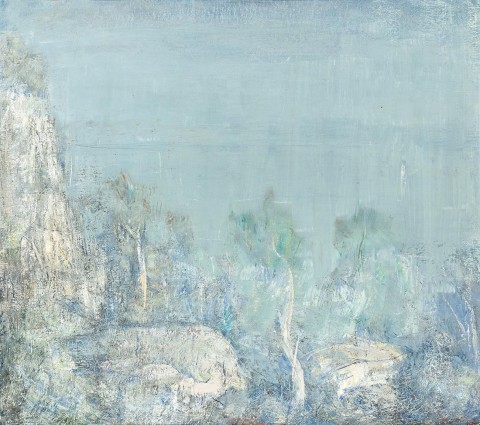MORNING ON THE DERWENT, 1971
LLOYD REES
oil on canvas
89.5 x 100.5 cm
signed and dated lower left: L REES 71
bears inscription on label verso: “Morning on the Derwent” / Lloyd Rees.
Dr Peter Elliott AM, Sydney,
acquired directly from the artist
Private collection, New South Wales,
acquired from the above in 2007
Fry, G., The Peter Elliott Collection of Australian Art, The Beagle Press, Sydney, 2013, p. 50 (illus.)
Lloyd Rees’ incredibly long career as a landscape artist can be broadly divided into five painterly divisions. Starting with his early work featuring Sydney and its environs, Rees subsequently captured scenes of Bathurst, the Illawarra and onwards to Europe, before his fifth and final sequence based around Tasmania. He first travelled to Hobart in the late 1960s following his son Alan’s relocation to work at the University of Tasmania. As the latter series unfurled, the artist and writer James Gleeson acknowledged that the later works were ‘something rare and profound, reminding us of the late styles of other great artists who reach their full creative powers. There is a simplification to the point of universal form; there is mastery of technique to the point where it no longer matters. There is a direct communication from the centre of the artist’s being’.1
In Tasmania, Rees painted in three main locations, at his son’s house, perched high on Sandy Bay with the Derwent in the distance; in a studio located in the grounds of the university; and at the house of his friend, the artist Jack Carrington Smith, also sited on the river. Due to the relatively low aspect of Morning on the Derwent, 1971, it is probable that this latter location was the site at which it was painted. In a scene enveloped in morning mist (a common Derwent occurrence), Rees has abandoned his usual crisp line in favour of form, with the rocks, trees and distant shoreline all hazily suggested in a teal/azure blue applied using a palette knife highlighted with white. At the time, Rees was utilising his own homemade PVA-based ‘plaster’ to build up a low impasto over which he would paint vigorously or, to use his own words, ‘roughly – attack them, as it were (but) it is from this attack that unity emerges (once) a canvas is well covered with paint’.2 He was always at pains to emphasise that his paintings were never topographically true for although he may begin with an accurate sketch of a scene, ‘painting is a creative process. It is not nature, it is a man-made thing’.3 Rees also admitted that ‘when I enter the studio, a different person seems to take over, the picture on the easel dominates and everything else fades away’.4
Rees mounted a large exhibition of his Tasmanian paintings at the Macquarie Galleries in 1971 and it is plausible that Morning on the Derwent was there under another name before being purchased by the noted obstetrician Peter Elliott. With his wife Jane, Elliott amassed a large collection of artworks often in association with the gallerist Rudy Komon (Elliott was at Komon’s bedside when he died). Over many years, they also formed strong friendships with artists in their collection particularly Brett Whiteley,5 Fred Williams and William Robinson, and representatives from a younger generation including contemporary artists such as Anne Wallace and Noel McKenna. Amidst all this visual splendour, Morning on the Derwent would no doubt have acted as a calm centre, a ‘shrouded mystery’6 painted by an artist fascinated by light, mood and paint.
1. Free, R., Lloyd Rees: the last twenty years, Craftsman House, Sydney, 1983, p. 13
2. The artist quoted in Free, R., op cit., p. 15
3. ibid., p. 15
4. Rees, L., Peaks and Valleys: an autobiography, Collins, Sydney, 1985, p. 227
5. Their son James Elliott married Arkie Whiteley.
6. Free, R., op cit., p.17
ANDREW GAYNOR
